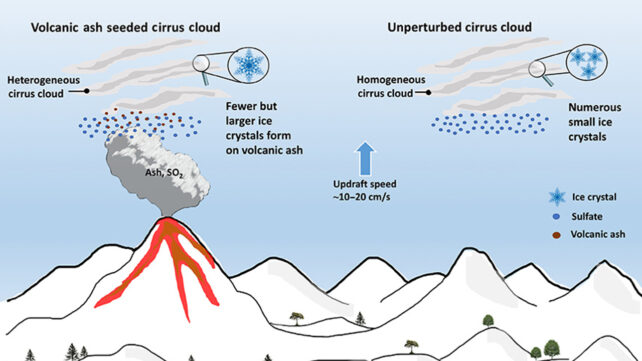Satellites soaring high above Earth have revealed exactly how wispy clouds are created by the giant plumes of ash belched upwards in a volcanic eruption.
Volcanoes play a vital role in the cycles governing Earth's climate. When active volcanoes erupt, they release gases like carbon dioxide and sulfur dioxide, which can have a warming or cooling effect.
Volcanic ash and dust are also released high in the atmosphere, injecting aerosols where clouds typically form.
For some time, scientists have wondered how these aerosols affect cloud formation. In a new study, researchers from the Lawrence Livermore National Laboratory (LLNL) concluded that volcanic ash particles can trigger the formation of wispy cirrus clouds high in the atmosphere by providing a nucleus that ice particles can glom onto – a process known as "ice nucleation."

"Our research helps close a significant knowledge gap about whether and how volcanic eruptions influence cloud formation," says LLNL atmospheric scientist Lin Lin. "We show that volcanic ash particles can trigger ice cloud formation by acting as sites for ice nucleation.
Clouds play a vital role in regulating Earth's climate and energy balance. In addition to covering about 70 percent of the surface at any given time, reflecting sunlight and absorbing heat, they're also an integral aspect of the planet's water cycle.
As such, a better understanding of cloud formation and the impact of aerosols is needed.
The research of Lin and and her team is based on 10 years of data from NASA's CloudSat and Cloud-Aerosol Lidar and Infrared Pathfinder Satellite (CALIPSO) missions.
CloudSat examines the interior of clouds to determine how tropical cyclones and climate changes (related to clouds) occur. CALIPSO monitors the roles clouds and aerosols play in regulating Earth's weather, climate, and air quality.
From their observations, Lin and colleagues noted consistent changes in the properties of cirrus clouds following three volcanic eruptions. Where ash-rich eruptions occurred, the researchers noted that these high-altitude clouds (largely composed of ice) became more frequent.

While these clouds hosted significantly fewer ice crystals compared to cirrus clouds at other times, the crystals did have were were larger. None of this occurred with ash-poor eruptions.
"At the beginning of the study, we did expect clouds affected by volcanic eruptions to look different from natural clouds, but not in the way we ultimately found," says Lin. "We anticipated that volcanic aerosols would lead to an increase in the number of ice crystals in clouds. But to our surprise, the data showed the opposite."
Initially, the group expected ice to form uniformly in a process whereby water spontaneously condenses from very cold water droplets. Instead, they observed water collecting on the ash aerosols before they were cold enough to freeze spontaneously, forming larger clumps of ice.
"The results completely overturned our original expectations," Lin adds. "Letting go of our initial idea and developing a new explanation based on unexpected findings was both the hardest and most rewarding part of the process."
Since then, the team has transitioned to studying Arctic clouds and their role in global atmospheric models. Meanwhile, they are waiting for another major eruption, which will allow them to validate their results.
This research was published in Science Advances.
